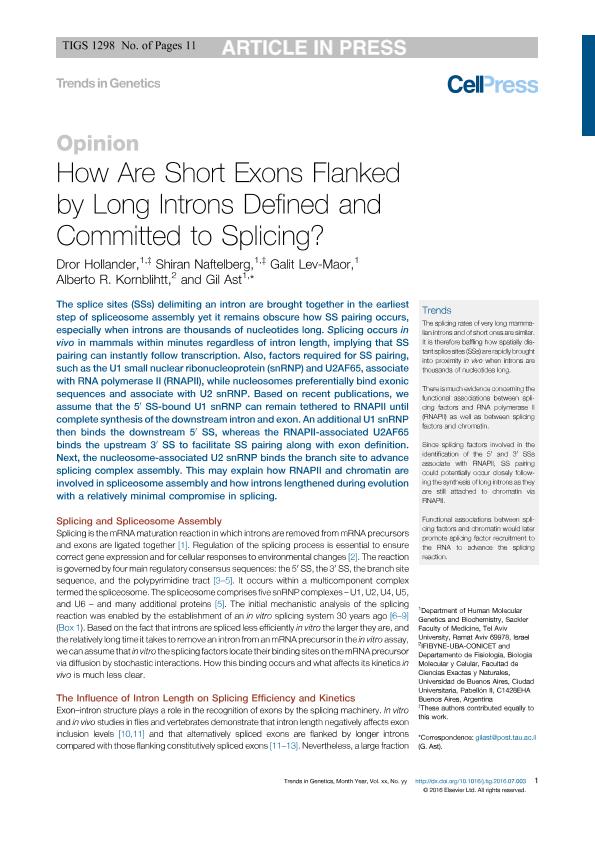Mostrar el registro sencillo del ítem
dc.contributor.author
Hollander, Dror
dc.contributor.author
Naftelberg, Shiran
dc.contributor.author
Lev Maor, Galit
dc.contributor.author
Kornblihtt, Alberto Rodolfo

dc.contributor.author
Ast, Gil
dc.date.available
2018-09-20T13:37:08Z
dc.date.issued
2016-10
dc.identifier.citation
Hollander, Dror; Naftelberg, Shiran; Lev Maor, Galit; Kornblihtt, Alberto Rodolfo; Ast, Gil; How Are Short Exons Flanked by Long Introns Defined and Committed to Splicing?; Elsevier Science London; Trends In Genetics; 32; 10; 10-2016; 596-606
dc.identifier.issn
0168-9525
dc.identifier.uri
http://hdl.handle.net/11336/60374
dc.description.abstract
The splice sites (SSs) delimiting an intron are brought together in the earliest step of spliceosome assembly yet it remains obscure how SS pairing occurs, especially when introns are thousands of nucleotides long. Splicing occurs in vivo in mammals within minutes regardless of intron length, implying that SS pairing can instantly follow transcription. Also, factors required for SS pairing, such as the U1 small nuclear ribonucleoprotein (snRNP) and U2AF65, associate with RNA polymerase II (RNAPII), while nucleosomes preferentially bind exonic sequences and associate with U2 snRNP. Based on recent publications, we assume that the 5′ SS-bound U1 snRNP can remain tethered to RNAPII until complete synthesis of the downstream intron and exon. An additional U1 snRNP then binds the downstream 5′ SS, whereas the RNAPII-associated U2AF65 binds the upstream 3′ SS to facilitate SS pairing along with exon definition. Next, the nucleosome-associated U2 snRNP binds the branch site to advance splicing complex assembly. This may explain how RNAPII and chromatin are involved in spliceosome assembly and how introns lengthened during evolution with a relatively minimal compromise in splicing.
dc.format
application/pdf
dc.language.iso
eng
dc.publisher
Elsevier Science London

dc.rights
info:eu-repo/semantics/openAccess
dc.rights.uri
https://creativecommons.org/licenses/by-nc-nd/2.5/ar/
dc.subject
Splicing
dc.subject.classification
Otras Ciencias Biológicas

dc.subject.classification
Ciencias Biológicas

dc.subject.classification
CIENCIAS NATURALES Y EXACTAS

dc.title
How Are Short Exons Flanked by Long Introns Defined and Committed to Splicing?
dc.type
info:eu-repo/semantics/article
dc.type
info:ar-repo/semantics/artículo
dc.type
info:eu-repo/semantics/publishedVersion
dc.date.updated
2018-09-19T14:35:28Z
dc.journal.volume
32
dc.journal.number
10
dc.journal.pagination
596-606
dc.journal.pais
Reino Unido

dc.journal.ciudad
Londres
dc.description.fil
Fil: Hollander, Dror. Tel Aviv University; Israel
dc.description.fil
Fil: Naftelberg, Shiran. Tel Aviv University; Israel
dc.description.fil
Fil: Lev Maor, Galit. Tel Aviv University; Israel
dc.description.fil
Fil: Kornblihtt, Alberto Rodolfo. Consejo Nacional de Investigaciones Científicas y Técnicas. Oficina de Coordinación Administrativa Ciudad Universitaria. Instituto de Fisiología, Biología Molecular y Neurociencias. Universidad de Buenos Aires. Facultad de Ciencias Exactas y Naturales. Instituto de Fisiología, Biología Molecular y Neurociencias; Argentina
dc.description.fil
Fil: Ast, Gil. Tel Aviv University; Israel
dc.journal.title
Trends In Genetics

dc.relation.alternativeid
info:eu-repo/semantics/altIdentifier/doi/http://dx.doi.org/10.1016/j.tig.2016.07.003
dc.relation.alternativeid
info:eu-repo/semantics/altIdentifier/url/https://www.sciencedirect.com/science/article/pii/S0168952516300798
Archivos asociados
